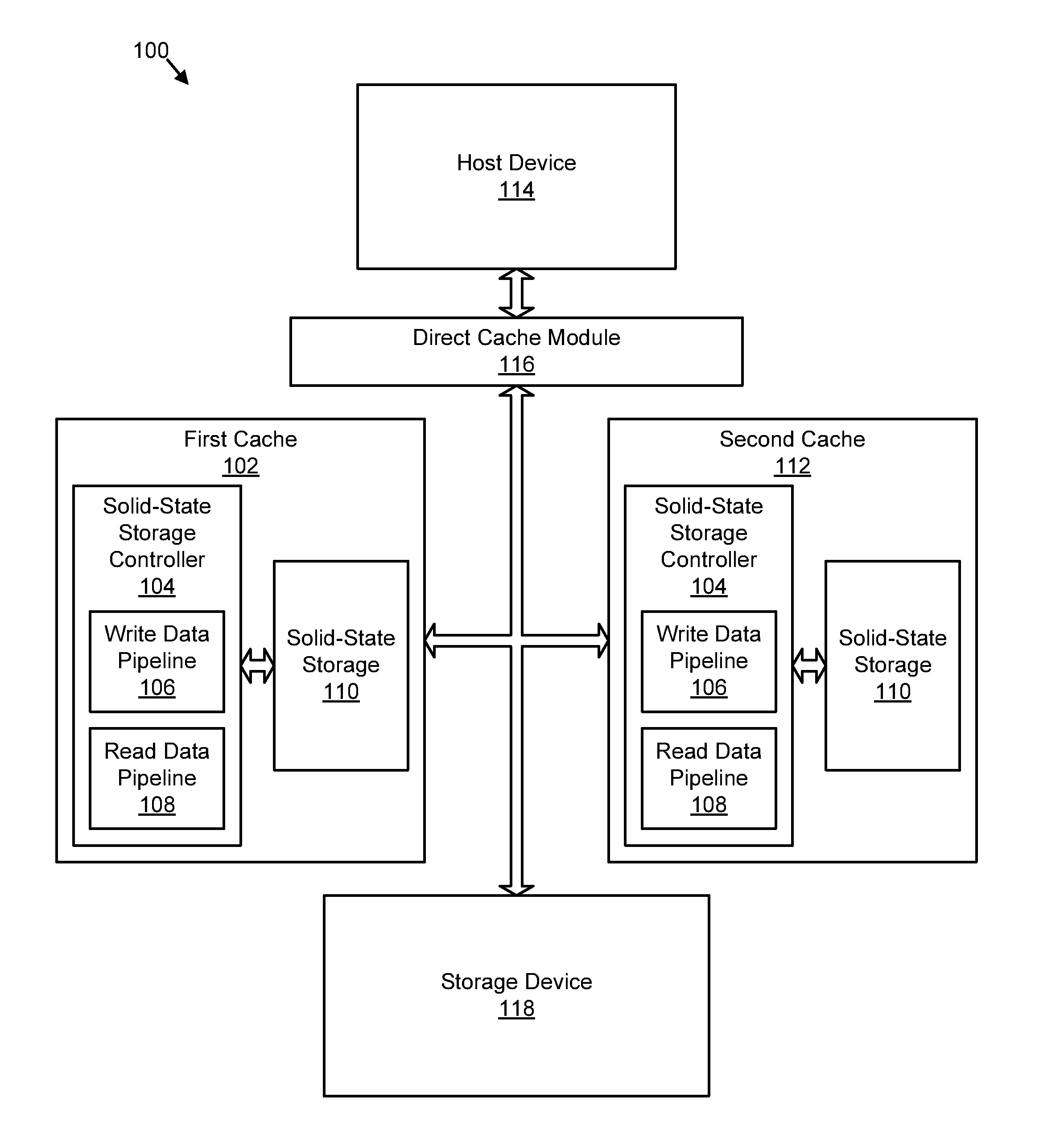Apparatus, system, and method for redundant write caching
- Summary
- Abstract
- Description
- Claims
- Application Information
AI Technical Summary
Benefits of technology
Problems solved by technology
Method used
Image
Examples
embodiment 300
[0128]FIG. 3 is a schematic block diagram illustrating one embodiment 300 of a solid-state storage controller 104 with a write data pipeline 106 and a read data pipeline 108 in a cache 102, 112 in accordance with the present invention. The embodiment 300 includes a data bus 204, a local bus 206, and buffer control 208, which are substantially similar to those described in relation to the solid-state storage device controller 202 of FIG. 2. The write data pipeline 106 includes a packetizer 302 and an error-correcting code (“ECC”) generator 304. In other embodiments, the write data pipeline 106 includes an input buffer 306, a write synchronization buffer 308, a write program module 310, a compression module 312, an encryption module 314, a garbage collector bypass 316 (with a portion within the read data pipeline 108), a media encryption module 318, and a write buffer 320. The read data pipeline 108 includes a read synchronization buffer 328, an ECC correction module322, a depacketize...
embodiment 800
[0268]FIG. 8A depicts one embodiment 800 of the first cache 102 and the second cache 112. The depicted embodiment 800 illustrates a portion of a logical address space shared by both the first cache 102 and the second cache 112. As used herein a logical address space shared by two caches means that a given logical address may be mapped to a physical location in both caches. This means that data for a given logical address can exist in one cache or the other cache, or both caches.
[0269]The depicted embodiment 800 includes logical addresses 804a-e for the first cache 102 and the second cache 112 and data 810 associated with the logical addresses 804a-e. In the depicted embodiment 800, the logical addresses 804a-e each mirror data 810 between the first cache 102 and the second cache 112.
[0270]In the depicted embodiment 800, the first cache 102 and the second cache 112 share a logical address space that includes the set of logical addresses 804a-e. In one embodiment, physical storage cap...
embodiment 820
[0274]In the depicted embodiment 820, the cache selection module 702 selects odd logical addresses 804 for the trim module 606 to clear data 810 from the first cache 102 and selects even logical addresses 804 for the trim module 606 to clear data 810 from the second cache 112. Once the trim module 606 has cleared data 810 corresponding to one or more odd logical addresses 804 from the first cache 102 and has cleared data 810 corresponding to one or more even logical addresses 804 from the second cache 112, at least a portion of the remaining data 810 is logically striped between the first cache 102 and the second cache 112, and data 810 corresponding to consecutive logical addresses 804 is stored by different caches 102, 112. It should be noted that while the shared address space is logically striped in the depicted embodiment, those of skill in the art recognize that the media of the caches 102, 112 may not be logically striped.
[0275]Clearing the data 810 corresponding to logical a...
PUM
 Login to View More
Login to View More Abstract
Description
Claims
Application Information
 Login to View More
Login to View More - R&D
- Intellectual Property
- Life Sciences
- Materials
- Tech Scout
- Unparalleled Data Quality
- Higher Quality Content
- 60% Fewer Hallucinations
Browse by: Latest US Patents, China's latest patents, Technical Efficacy Thesaurus, Application Domain, Technology Topic, Popular Technical Reports.
© 2025 PatSnap. All rights reserved.Legal|Privacy policy|Modern Slavery Act Transparency Statement|Sitemap|About US| Contact US: help@patsnap.com



